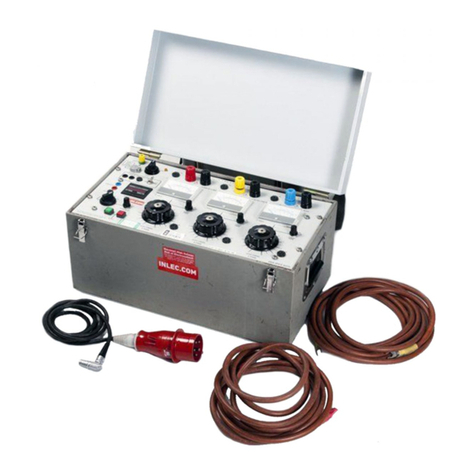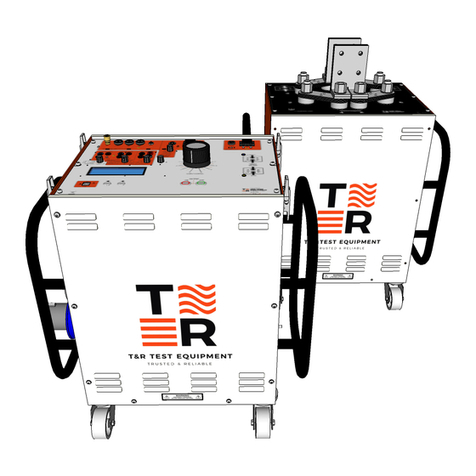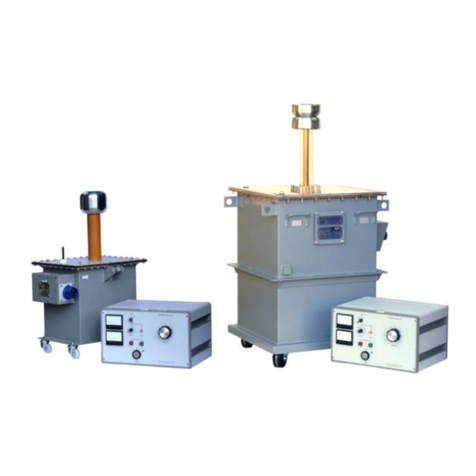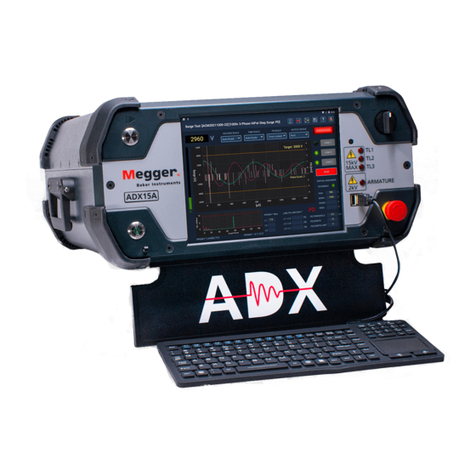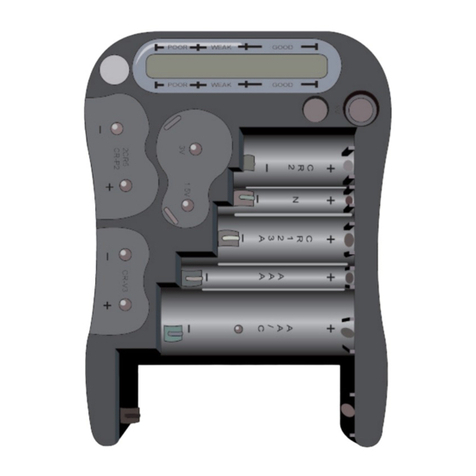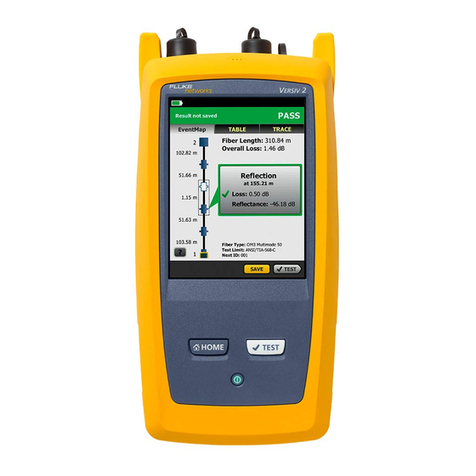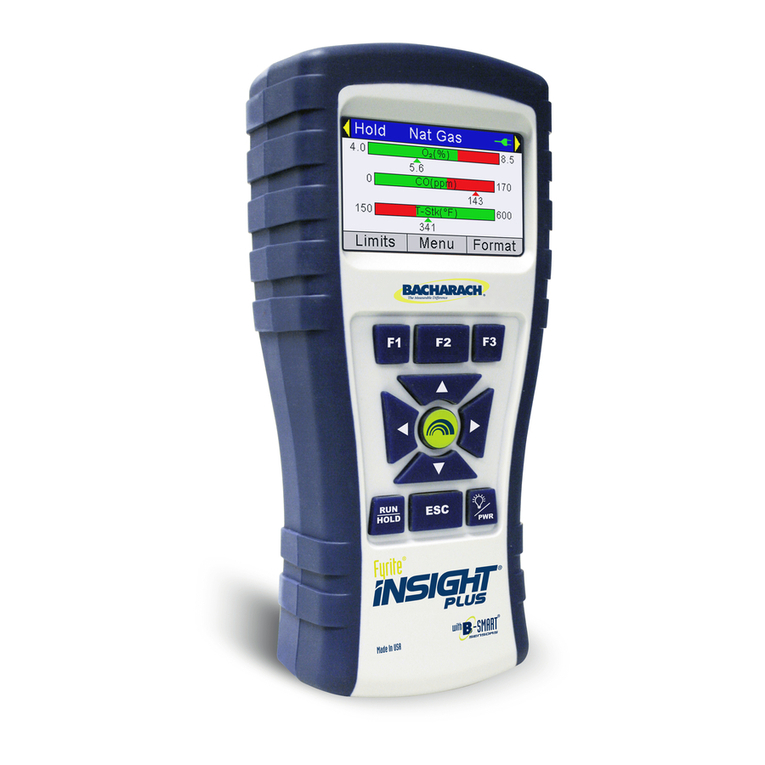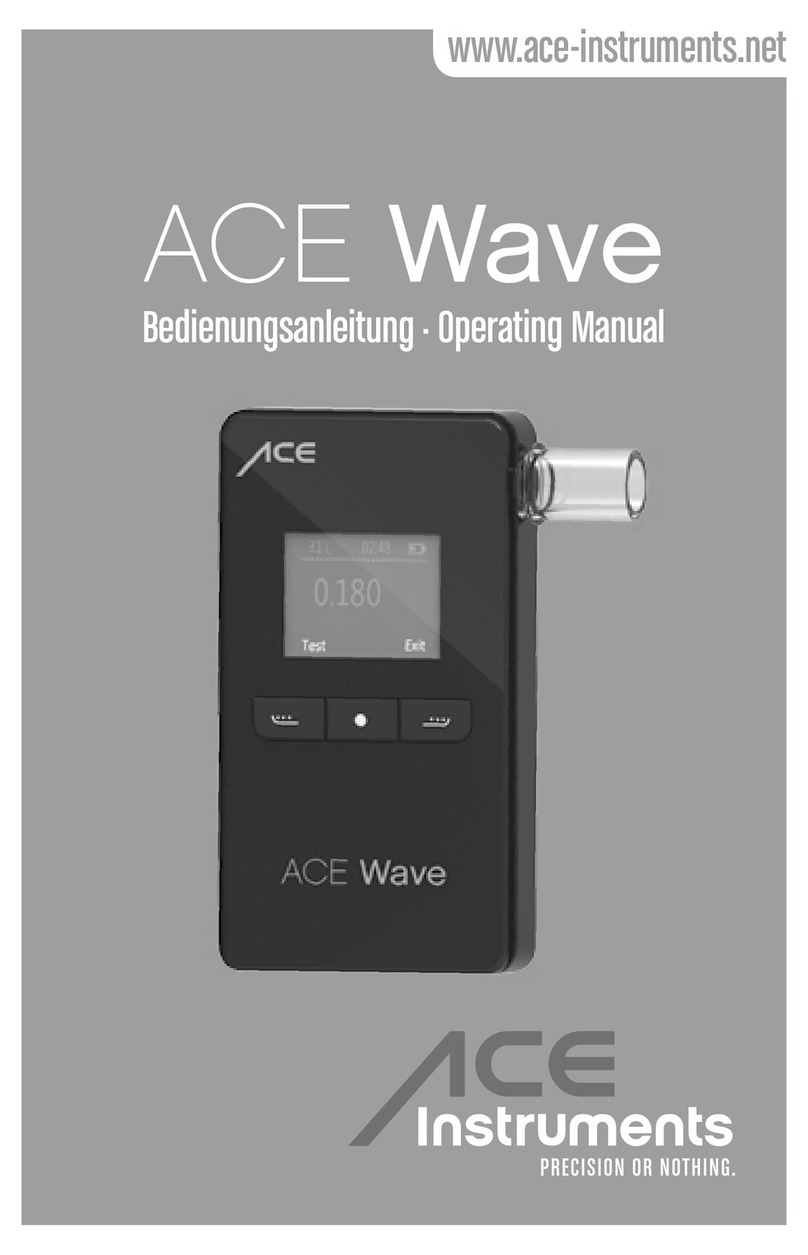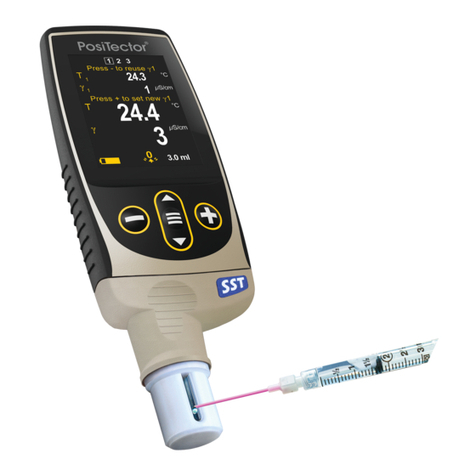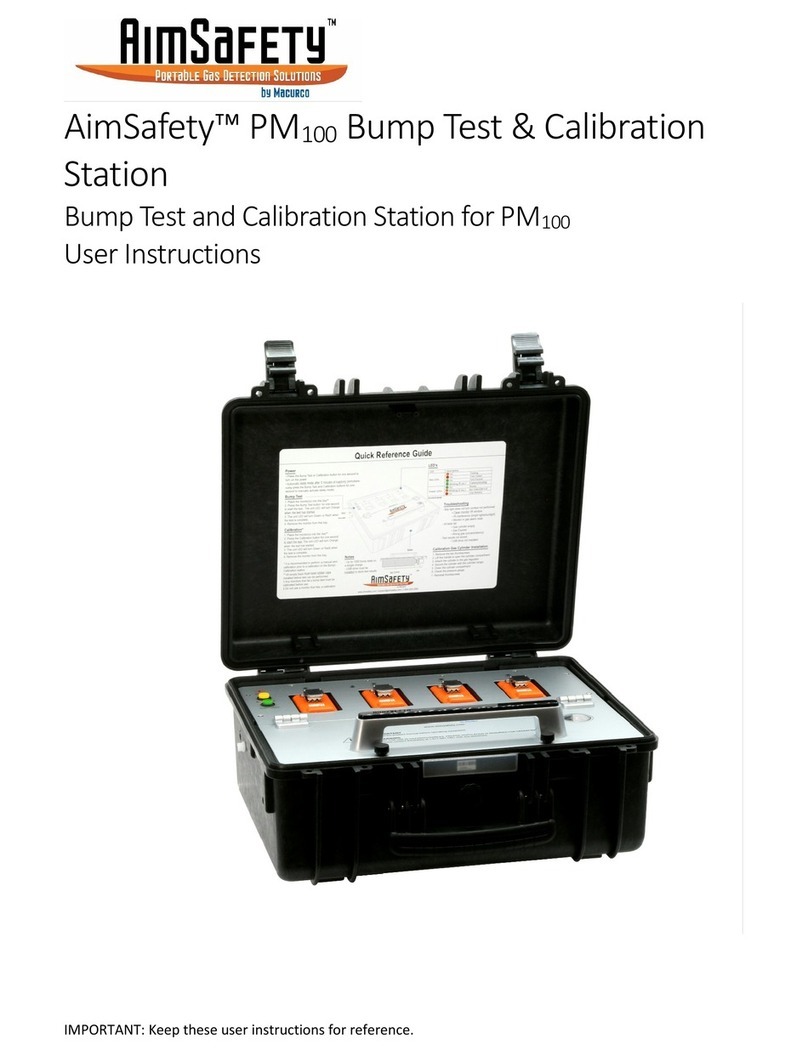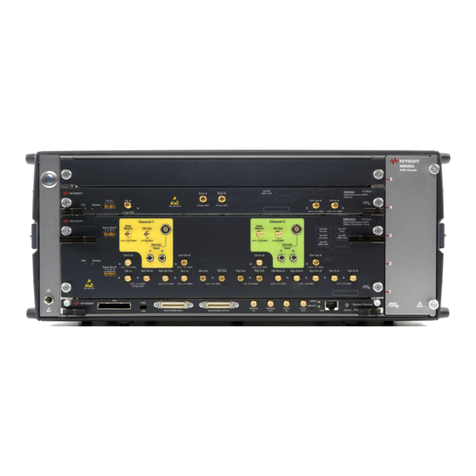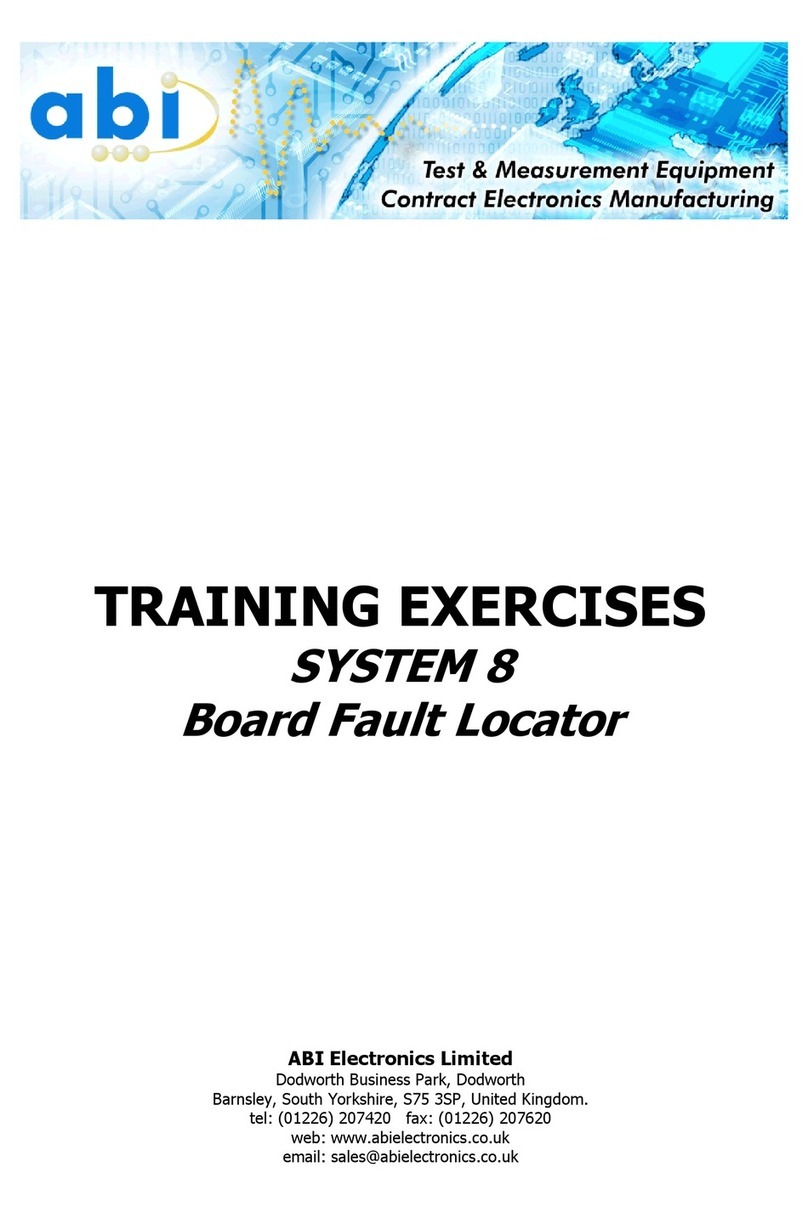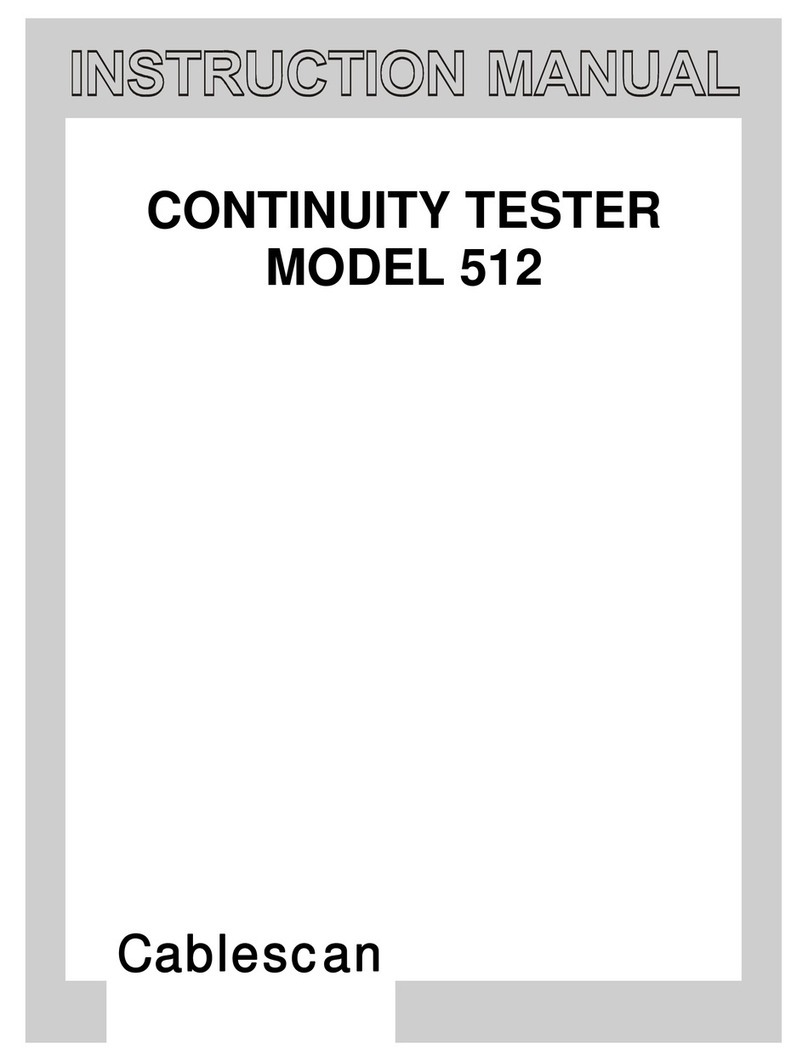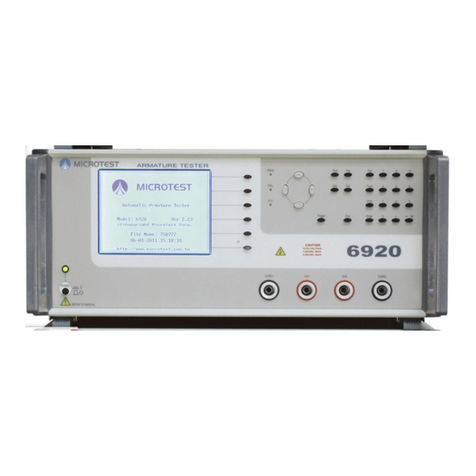T&R KV30-40D mk3 Operating instructions

1
OPERATING AND MAINTENANCE MANUAL
Product: High Voltage AC Test Set
Type: KV30-40D mk3 or KV15-80D mk3
DESIGNED AND MANUFACTURED BY:
T & R Test Equipment Limited
15-16 Woodbridge Meadows, Guildford, Surrey, GU1 1BJ, United Kingdom
Telephone: 01483 207428 e-mail: sales@trtest.com Web www.trtest.com

2

3
GENERAL SAFETY STATEMENT
WARNING
The following safety precautions should be reviewed to avoid injury to the user and damage to the product
(and other products connected to it). To avoid potential hazards only use this product as specified.
Only suitably qualified personnel should use this equipment. Servicing of this product should
only be carried out by suitably qualified service personnel.
The high voltage generated by this unit is extremely dangerous and may be fatal.
To Avoid Fire Hazards and Personal Injury
Use the correct power supply lead. Only use a suitably rated and approved power supply lead for the
country of use.
Ensure that systems that the unit is to be connected to are dead.
Do not connect and disconnect leads whilst outputs are switched on.
Ensure that the product is grounded. To avoid electric shock, it is essential that the grounding
conductor is connected to the earth ground. Additional earth terminals are provided on the control unit
and high voltage (HV) transformer that must be connected to a local earth. Ensure that the unit is
properly grounded before making any connections to inputs or outputs.
Terminal ratings must be observed to prevent fire hazards and risk of injury to the operator. Consult
the product manual for ratings information before making connections to any terminal.
It is ESSENTIAL to consult the product manual for rating information before making any connection to
a terminal or terminal group marked with a warning triangle.
Only use fuses of a type and rating specified for this product.
Do not operate the unit out of its case or with any covers or panels removed.
Do not touch exposed connections and components when power is present.
Do not operate the product if any damage is suspected. Refer the unit to qualified service personnel
to be checked.
Do not operate the unit in wet or damp conditions
Do not operate the unit in an explosive atmosphere
If any further queries occur regarding the usage and maintenance of the
equipment detailed in this manual, please refer these to the supplier of the
equipment in the first case or to:
T & R Test Equipment Limited

4
HIGH VOLTAGE SAFETY
It is essential to follow safe working procedures when working with high voltage. Information on
accepted codes of practice should be obtained from your local heath and safety regulatory body.
It is essential that the KV30-40D mk3 and KV15-80D mk3 series test sets are only used in a
suitable test environment. EN50191:2010 (Erection and Operation of Electrical Test Equipment)
provides information on the installation and use of test installations and is referenced by health
and safety law in the EU.
IEEE standard 510-1983 (IEEE Recommended Practices for Safety in High-Voltage and High-
Power Testing) also provides a working framework for establishing safe procedures, but must
be read in conjunction with local regulations and accepted codes of practice. Although this
standard has since been withdrawn, it does contain very good practices that are still referenced
today, the following excerpts are taken from IEEE 510:
All ungrounded terminals of the test equipment or apparatus under test should be
considered as energised.
Common ground connections should be solidly connected to both the test set and the test
specimen. As a minimum, the current capacity of the ground leads should exceed that
necessary to carry the maximum possible ground current. The effect of ground potential rise
due to the resistance and reactance of the earth connection should be considered.
Precautions should be taken to prevent accidental contact of live terminals by personnel,
either by shielding the live terminals or by providing barriers around the area.
The circuit should include instrumentation for indicating the test voltages.
Appropriate switching and, where appropriate, an observer should be provided for the
immediate de-energisation of test circuits for safety purposes. In the case of dc tests,
provisions for discharging and grounding charged terminals and supporting insulation
should also be included.
In the use of signal-gathering equipment, each device should be used in such a manner that
it will not present a personnel hazard should it inadvertently become a part of the high-
voltage circuit, or fail to function properly.
High-voltage and high-power tests should be performed and supervised by qualified
personnel.
Consideration should be given to safety regulations which may apply to specific
circumstances; for example, HSE, company, or government regulations.

5
SAFETY TERMS AND SYMBOLS
The following safety symbols appear on the equipment:
CAUTION/WARNING – Refer to manual
DANGER – High voltage
Mains off
Mains on
The following safety symbols appear in this manual:
CAUTION
This action or procedure may be dangerous if not carried out
correctly, and may cause damage to the equipment or
connected equipment.
WARNING
This action or procedure may be cause injury or death to the
operator or other personnel if not carried out correctly using
applicable safety procedures.


7
CONTENTS
1. DESCRIPTION OF EQUIPMENT 9
1.1 Front Panel Overview 10
1.2 Electrical Specification 12
1.2.1 Supply Requirements 12
1.2.2 Output Specifications 12
1.2.3 Zero Voltage Interlock 12
1.2.4 External Interlock 12
1.3 Output Voltage Control 13
1.4 Overload Protection 13
1.4.1 Variable Overload 13
1.5 Metering 14
1.6 Construction 14
2. OPERATION 15
2.1 Safety 15
2.1.1 Installation 15
2.1.2 Operation 15
2.2 Connections (See Figure 2) 18
2.4 Method of Operation 20
3. MAINTENANCE 21
3.1 Removal of Unit from Case 21
4. STANDARD ACCESSORIES 22
5. OVERALL PERFORMANCE SPECIFICATION 23
6. REVISION 25


9
1. DESCRIPTION OF EQUIPMENT
The KV30-40D mk3 is a flexible high voltage AC test system, capable of producing 30kV into a
variety of loads with a maximum of 40mA of current.
The KV15-80D mk3 is a similar high voltage AC test system, capable of producing 15kV into a
variety of loads with a maximum of 80mA of current.
The unit has been designed for general purpose testing insulation systems and measurement
of breakdown voltage on electrical plant, switchgear and components.
Improved digital metering for both accuracy and precision gives the user the ability to read a
digital value and have a visual indication of a ‘needle’.
The equipment has been designed to allow the user/operator to connect the product to an
external test setup with interlocks, and now includes a twist to release emergency stop button.
A timer has been included for timed tests on insulation systems, to meet national and
international testing standards.

10
1.1 Front Panel Overview
Figure 1.1 KV30-40D mk3 front panel
C
B
D
E
F
G
H
J
I
K L M
O
N
P
Q
R
A

11
Ref Item Function
A Earth Terminal Connect the unit to a local ground for safety
B Mains Input Connector Mains supply
C Mains Input Fuse Protection
D Interlock Connector Connect the unit to an external interlock
circuit
E mA Digital Meter Display mA metering
F Mains On/Off Switch Key operated mains switch
G Mains Lamp Mains on indicator
H Timer Range Switch Selects timer setting
I Primary Trip Transformer Primary circuit breaker
J Timer Cancel Button Cancels timer
K Main Output ON Control Switches main output ON
L Main Output OFF Control Switches main output OFF
M Main Output Control Controls the output voltage/current.
N mA Trip Range Switch Selects mA trip current
O mA Trip Reset Switch Resets mA trip
P kV Digital Meter Display kV metering
Q Emergency Stop Switch Emergency Stop
R Main Output Cable High Voltage output cable

12
1.2 Electrical Specification
1.2.1 Supply Requirements
The KV30-40D mk3 and KV15-80D mk3series have a 115/230V auto-selecting mains input.
Supply requirements: 115/230V 10% 1 phase 50/60Hz 1400VA max
1.2.2 Output Specifications
The output voltage, current and duty cycle are as follows:
Unit type Output Voltage
Output current
Continuous 5 min on/15 min off
KV30-40D mk3 30kV 20mA 40mA
KV15-80D mk3 15kV 40mA 80mA
One side of the high voltage transformer output is connected to the earth system of the
equipment.
1.2.3 Zero Voltage Interlock
The equipment is fitted with a zero volt interlock system on the controlling regulator. This
interlock prevents the output being energised unless the controlling regulator is in the minimum
output position.
1.2.4 External Interlock
The KV30-40D mk3 and KV15-80D mk3 is fitted with a 24Vdc external interlock socket. This
interlock prevents the output being energised unless an external circuit is closed. The interlock
circuit may also be used to connect normally closed emergency off switches to the unit wired in
series with any interlock switches.
The interlock circuit uses a 4 pin XLR type latching plug and socket with the circuit wired to pins
1 and 2. Pins 3 and 4 are not connected. The connections below are shown from the rear of
the interlock circuit plug.
Please note that the unit will not operate without either an external interlock circuit connected or
the shorting plug provided with the unit.

13
1.3 Output Voltage Control
The output is controlled from zero by means of a regulating transformer. The transformer is
operated by means of a control knob which is located on the front panel. To increase the output
voltage the knob is turned in a clockwise direction.
1.4 Overload Protection
The equipment is fitted with fixed and variable overload protection circuits as standard.
1.4.1 Variable Overload
The variable overload protection system senses current changes in the high voltage circuit. The
trip level is adjusted by means of a selector switch on the front panel of the unit. The switch
allows the level to be adjusted from 10-110% of normal full load current in eleven steps.
The circuit will activate when the load current exceeds that set by the trip level selector switch.
The circuit will respond more slowly to slowly changing levels of load current.
IMPORTANT NOTE: The variable overload trip circuit does not limit the output
current on short circuit.

14
1.5 Metering
The equipment is fitted with a kV meter that measures the output voltage via a resistive divider
in the HV circuit. It is also fitted with a mA meter that meters the output current in the earthy
end of the HV side of the output transformer.
Unit type
KV meter mA meter
FSD Resolution FSD Resolution
KV30-40D mk3 40kV 0.01kV 50mA 0.01mA
KV15-80D mk3 20kV 0.01kV 90mA 0.01mA
NOTE – Due to the nature of the digital meters, a non-zero reading may be
displayed when the output is off. This should not exceed 0.2 on either meter.
1.6 Construction
The equipment is housed in a robust case with recessed carrying handles. All the controls and
metering are located on the front panel together with all external connections.

15
2. OPERATION
2.1 Safety
The outputs from the KV30-40D mk3 and KV15-80D mk3 are extremely dangerous, and if used
incorrectly could be fatal. The unit must only be installed, operated, and maintained by suitably
qualified and trained (skilled) personnel.
It is essential to follow accepted safety procedures, and local health and safety regulations and
guidelines when installing and operating high voltage equipment. A risk assessment should be
undertaken on both the installation and the working procedures to ensure the safety of test
personnel and all other personnel. EN50191:2010 Defines suitable test installations for this
equipment.
2.1.1 Installation
2.1.1.1 Test Area
The unit must be installed in a suitable high voltage test area completely enclosed by walls or
some type of physical barrier. Appropriate controls and safety measures must be applied to this
area including interlocks connected to the supply or HV unit interlock to ensure that the unit
cannot be switched on unless the area is secure. Refer to EN50191:2010 for further details of
suitable test enclosures. The test area must also be identified with suitable signs.
2.1.1.2 Mains supply
The unit must be connected to a suitable supply via an approved and suitably rated mains
connector with earth connection.
2.1.1.3 Earthing
Particular attention must be made in earthing the equipment, and all earth connections must be
made with substantial conductors with secure joints.
The earth connection on the unit must be connected to a suitable low impedance earth in
addition to the mains earth to the unit.
The earth return from the test object must also be made with a suitable conductor back to the
earth point on the unit.
All earth connections must be able to withstand the largest fault current that may be encountered
in the system.
2.1.2 Operation
It is essential that safe working practices are maintained when conducting high voltage
testing. Safe working procedures must be implemented to accepted standards.
2.1.2.1 Interlocks
The unit is provided with an external interlock circuit that may be used to link to interlock switches
and emergency off switches around a high voltage test area. If no external interlock circuit is
connected, the shorting plug supplied with the unit must be fitted.

16
An interlock should be considered to be a safety back-up feature. An interlock should not be
regarded as a substitute for adequate safety rules and proper operator vigilance.
2.1.2.2 Grounding of the high voltage output
A temporary ground should be applied to the high voltage output when the circuit has been de-
energised using the earth stick provided. When connections are made, or disconnected, the
circuit either side of the connection should be grounded first. Extra earth sticks are available
from T&R Test Equipment as an optional accessory.
If the test circuit includes capacitors, each capacitor should be grounded separately before
connections are made or broken. In the case of capacitors connected in series, the intermediate
terminals should also be grounded.
It is good practice for all capacitive devices to remain short-circuited when not in use.
2.1.2.3 High voltage connection
The HV connection to the test object must be made securely to the test object. Suitable stress
relief components should be used where required to keep electrical stresses within acceptable
limits.
2.1.2.4 High voltage output clearances
The high voltage output from the unit is from a screened cable with an un-screened termination,
and adequate clearances must be maintained between the following parts and any other
conducting object (whether earthed or not):
HV output connection
Non-screened part of output cable (between the bulge in the cable and the output clip)
Non-grounded parts of test object
Any part of the test object not connected to earth should be considered live at the test voltage
potential.
Particular attention should be paid to clearances between any parts of the test object at test
voltage potential and the test enclosure or barriers.

17
EN50191:2010 defines the safety clearance around the high voltage circuit as the prohibition
zone, and stipulates that is must not be possible for personnel or their tools to touch this zone.
The prohibition zone distances for the units are shown below.
Unit Voltage Prohibition zone
KV30-40D mk3 30kV 170mm
KV15-80D mk3 15kV 85mm
EN50191:2010 also details suitable barrier types and heights such that the prohibition zone
cannot be reached by personnel.
2.1.2.5 Emergency Stop
The output can be immediately terminated by pressing the emergency stop. This has a twist to
release mechanism. When activated the unit immediately terminates the High Voltage output.
2.1.2.6 Timer
The timer has two controls: select test time and alarm cancel. When a test time is selected; the
timer starts when the output is switched ON. During the test, the lamp on the CANCEL button
will flash. When the pre-set test time has elapsed the lamp in the CANCEL button will illuminate
and an intermittent audible alarm will sound. To cancel the alarm press the CANCEL
pushbutton.

18
2.2 Connections (See Figure 2)
Before making any connections, please ensure that you are aware of all hazards relating
to the system and environment in which it is operating.
The input lead on the control unit should be connected to a suitable three pin supply connector.
Connect the earth lead from a reliable, efficient earth to the earth terminal on the equipment.
Connect the earth hook lead to the earth terminal on the test set and place the hook on the test
object's high voltage terminal.
IMPORTANT
The output cable is only partially screened. It is therefore essential that the minimum
clearance defined in 2.1.2.4 be maintained around the unscreened portion of the output
cable.
Figure 2 Connection showing earthed test object – before start of test
Note:-The test object is shown earthed via the earth stick as it should be between
tests and before any adjustment to the test object. The earth stick should be removed
from the test object before the test, and replaced after the test is complete.
screened part of HV cable
unscreened part of HV cable
Supply cable
To local earth
screen limit and stress relief
Earth return
Earth stick Test object


20
2.4 Method of Operation
Connect the equipment as described in Section 2.2.
Remove the mains power switch operating key before connecting the equipment to the main
supply. This will ensure the equipment is in the OFF position as the key is only removable in
that position.
Once the equipment is connected to the mains supply the key operated switch can be turned to
the ON position. The following will now occur:
a. Power ON lamp will be lit
b. HV OFF lamp will be lit
c. The Digital Meters will boot up.
d. The variable overload reset lamp will be lit
Press the variable mA Trip reset push-button thus arming the circuit. The indicator lamp in the
reset push-button will go out thus indicating that the circuit is armed.
Check that the primary trip circuit breaker is closed and the external interlock circuit is closed or
the shorting plug is fitted.
Set the desired overload mA trip level.
If required, set a desired test time.
Before commencing a test ensure that the regulator is in the fully anticlockwise position at ‘0’.
Depress the HV ON push-button - this will close the internal circuit breaker. The HV OFF lamp
will extinguish and the HV ON lamp will be lit. The output voltage can now be increased to the
desired level as indicated on the kV meter.
In the event of a test object failure the HV output will be automatically switched off by the
protection system. Depending on the level of the fault, either the electronic trip or the primary
trip circuit breaker will operate.
When the test is completed, turn the regulator control knob fully anti-clockwise and switch off
the HV output and then the main supply.
It is best practice to ‘0’ the regulator control knob after each test.
Before disconnecting the test object ensure the HV connection is grounded using the
earthing stick provided.
This manual suits for next models
2
Table of contents
Other T&R Test Equipment manuals
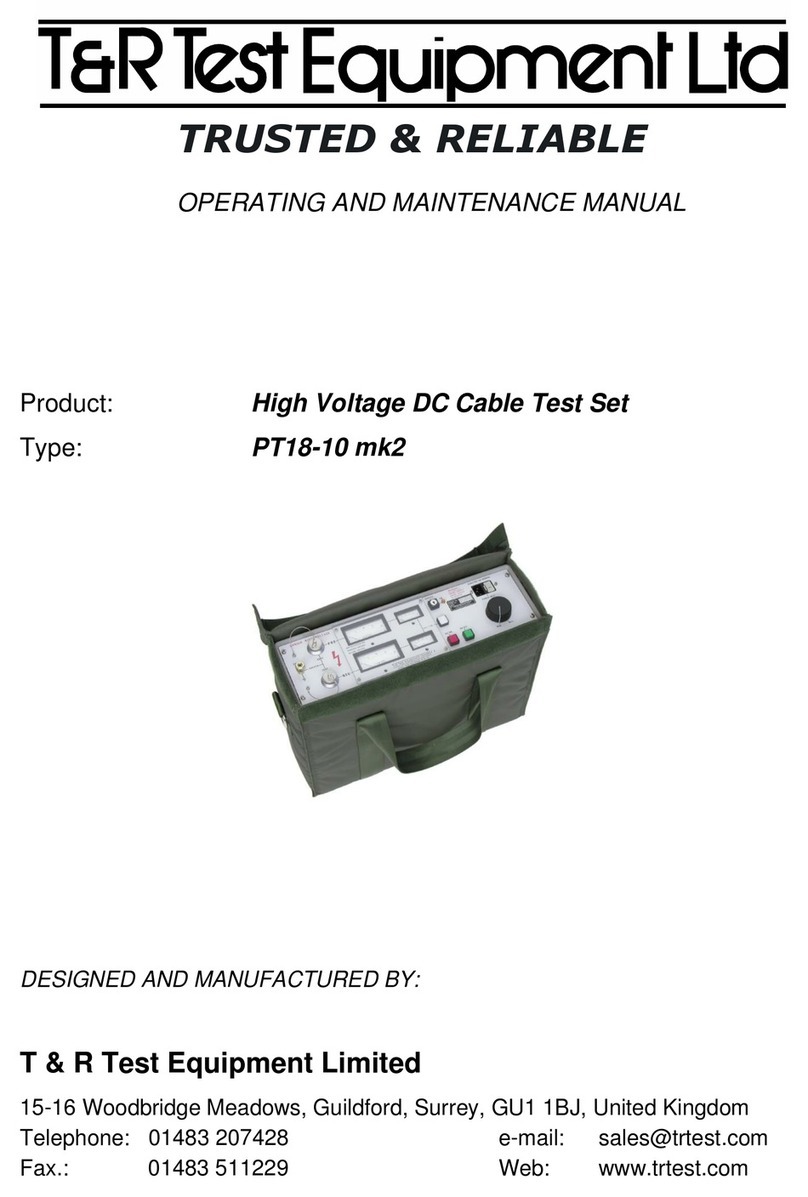
T&R
T&R PT18-10 mk2 Operating instructions
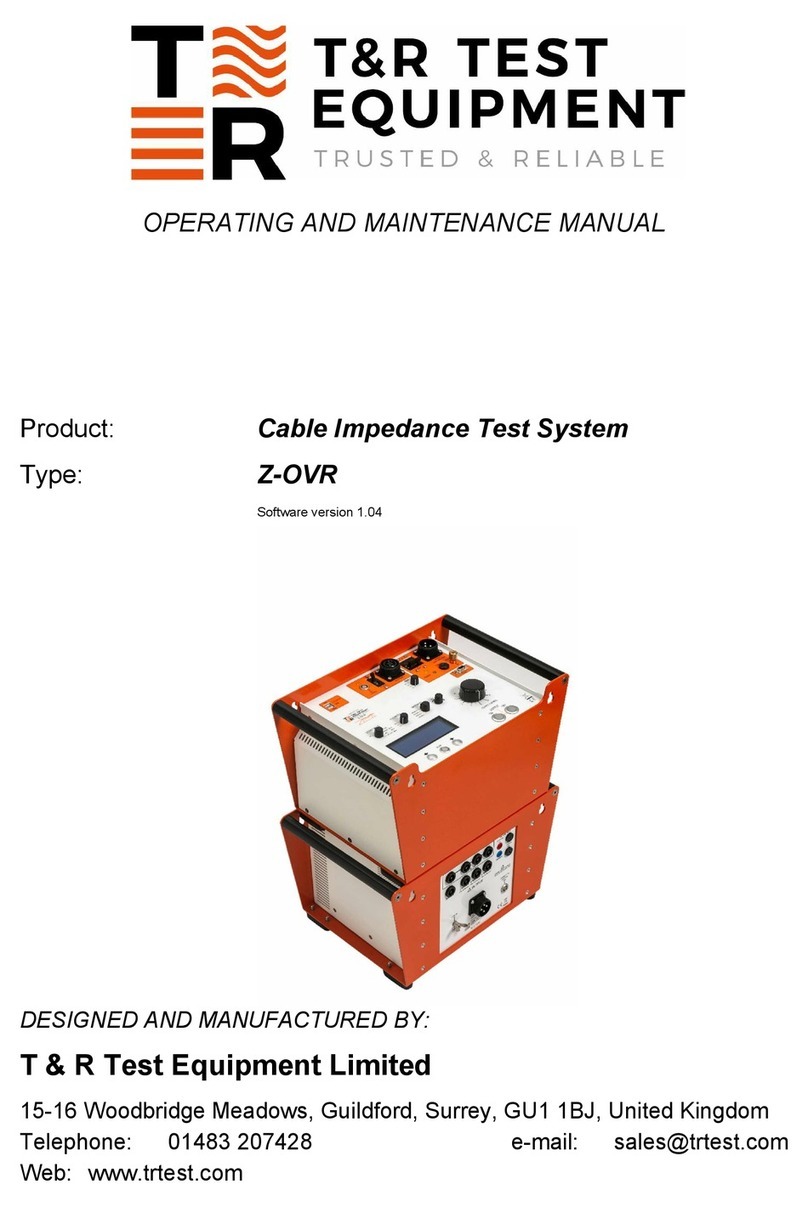
T&R
T&R Z-OVR Operating instructions
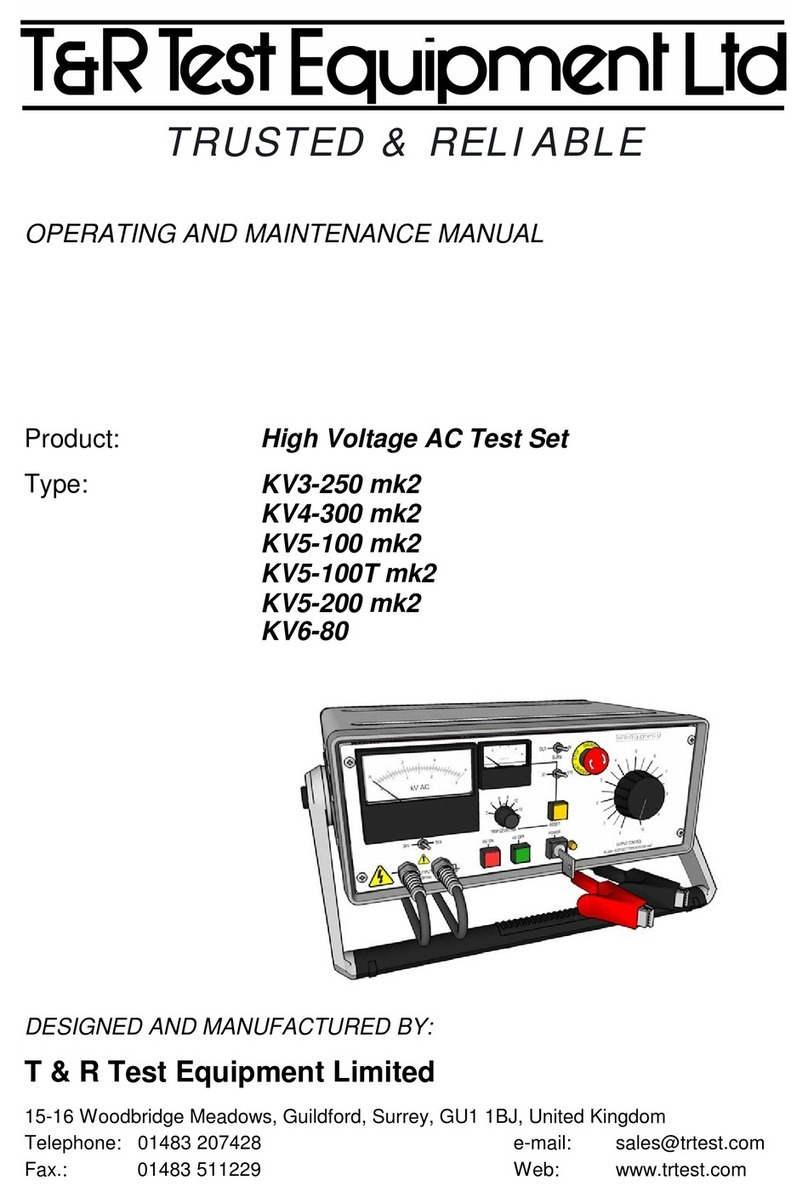
T&R
T&R KV6-80 Operating instructions
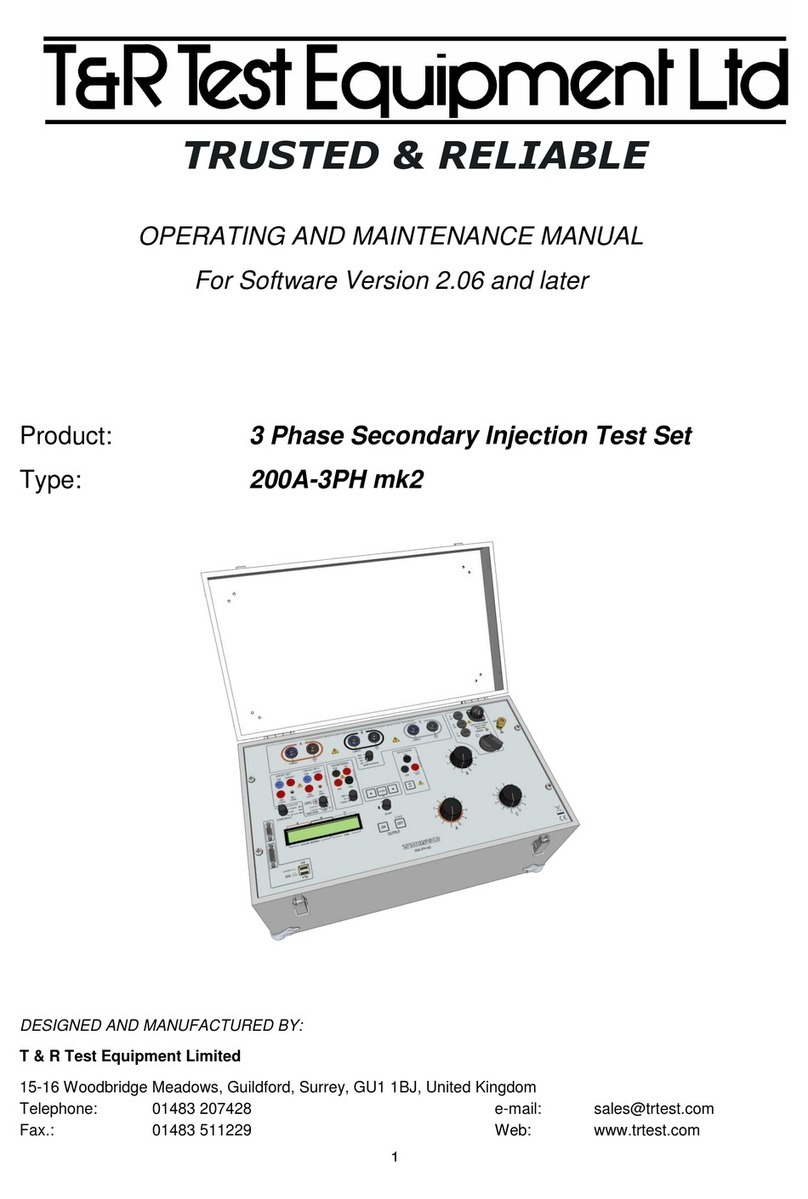
T&R
T&R 200A-3PH mk2 Operating instructions
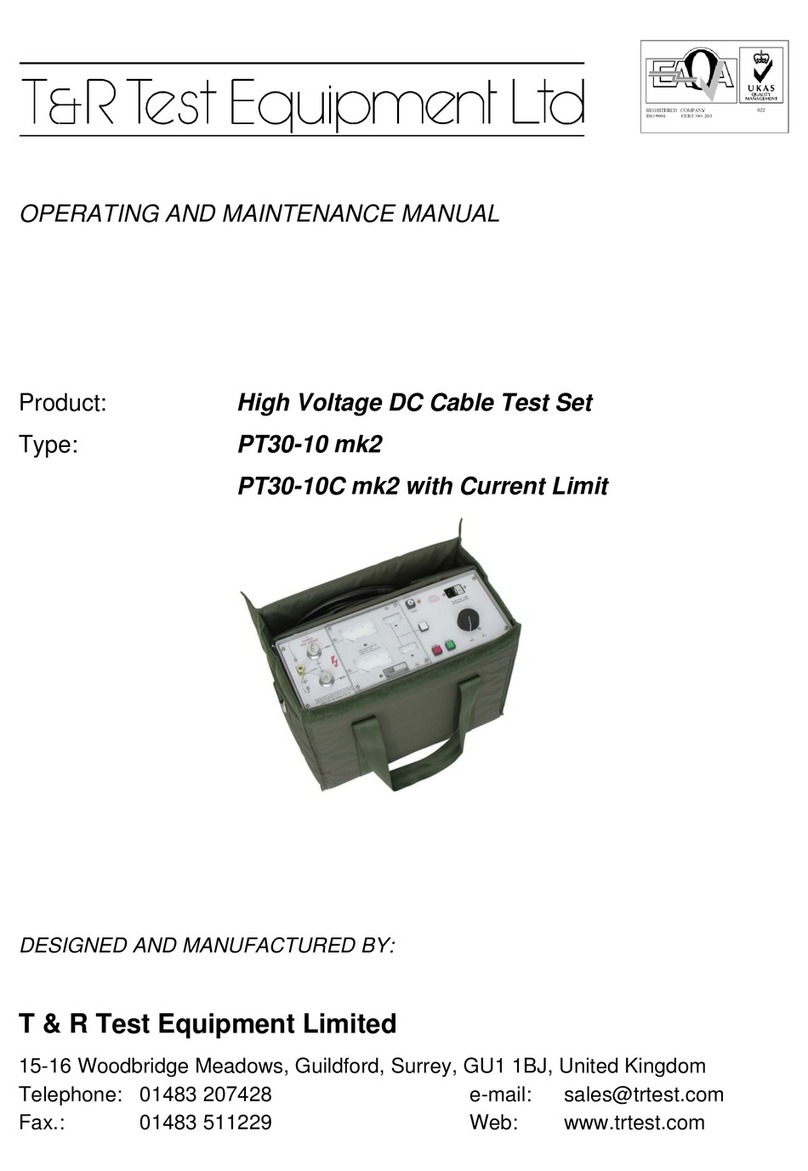
T&R
T&R PT30-10 mk2 Operating instructions
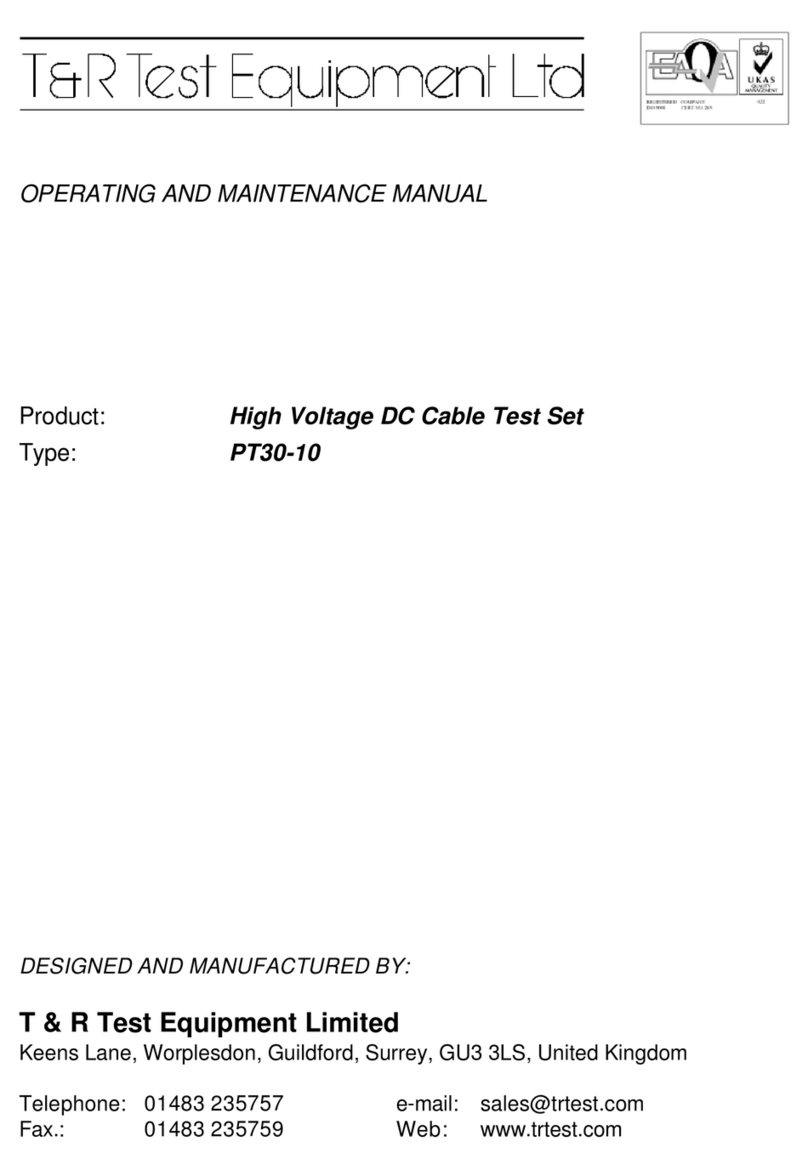
T&R
T&R PT30-10 Operating instructions
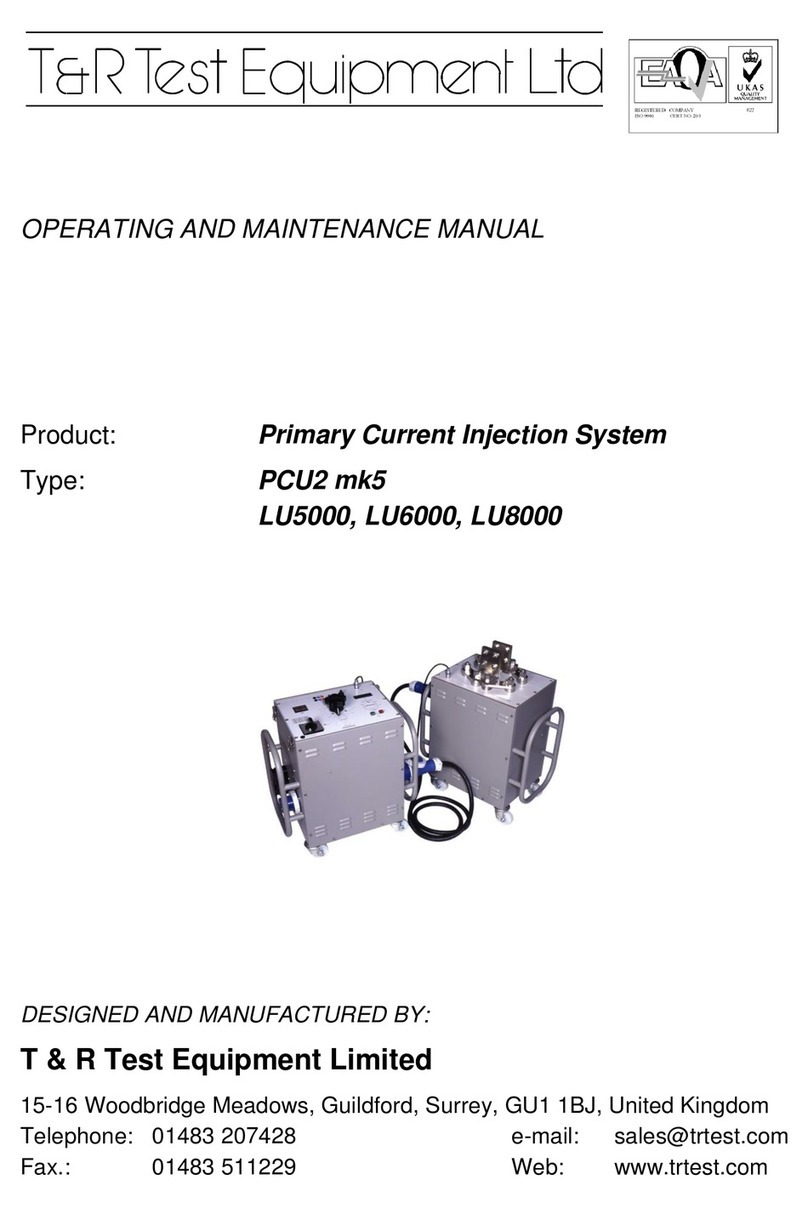
T&R
T&R PCU2 mk5 Operating instructions
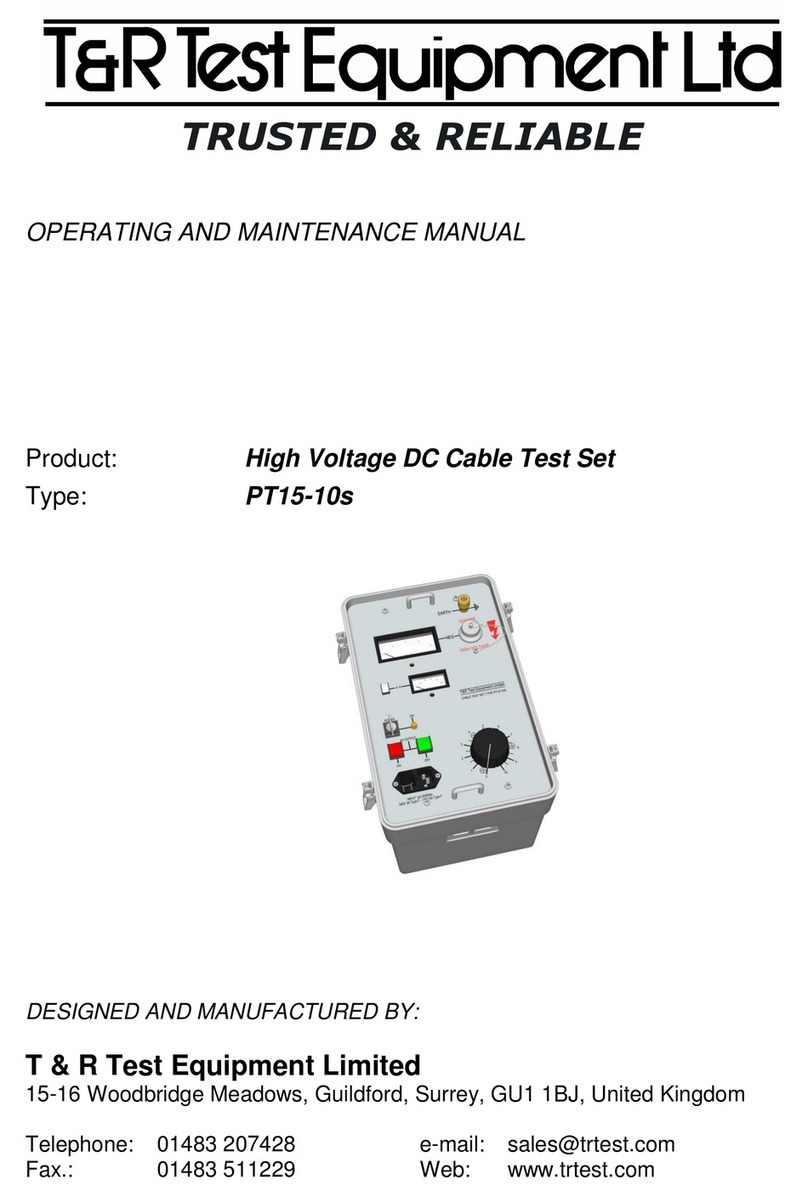
T&R
T&R PT15-10s Operating instructions
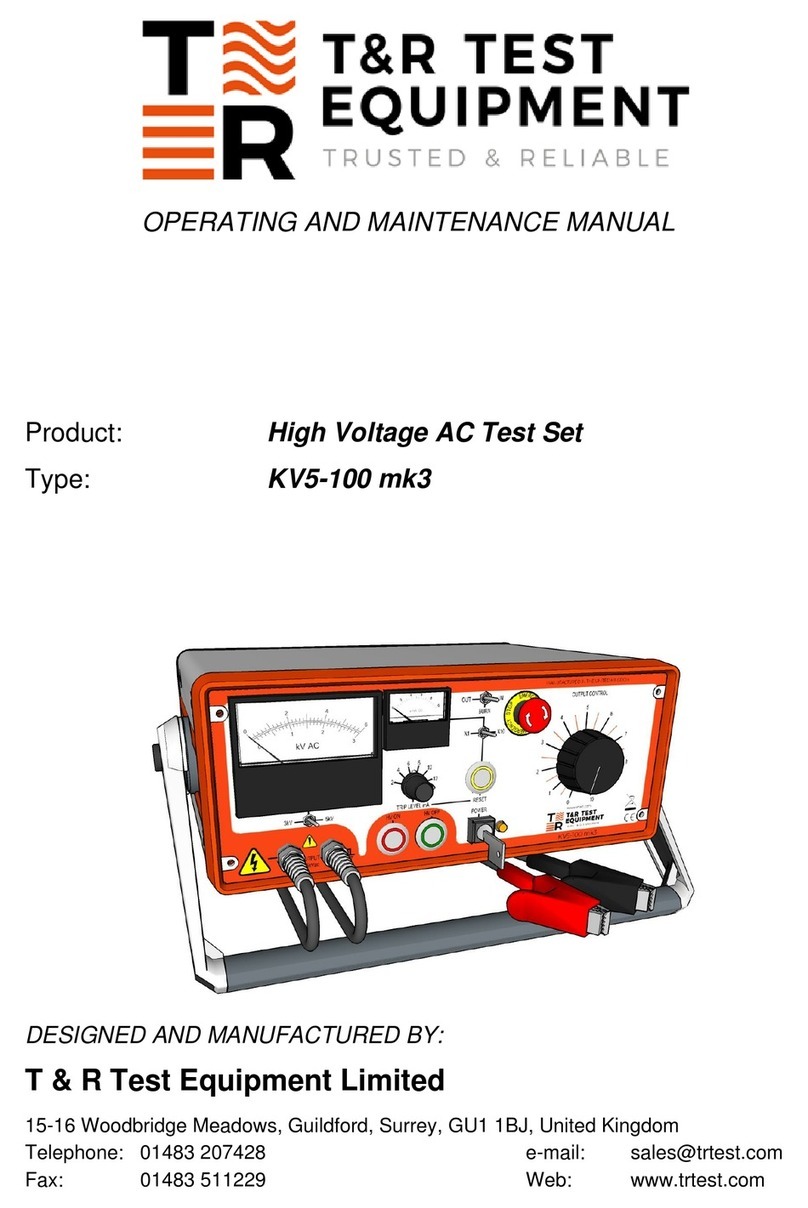
T&R
T&R KV5-100 mk3 Operating instructions
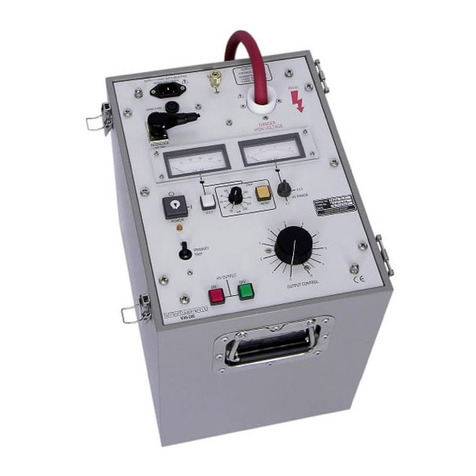
T&R
T&R KV30-40 Operating instructions
